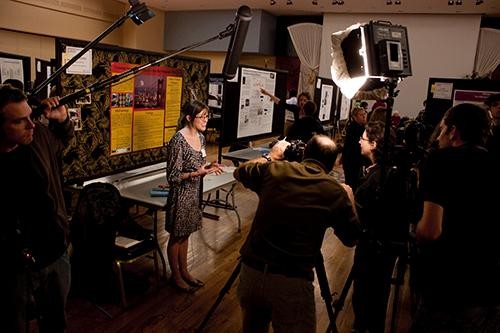UA undergraduate students in the Honors College presented research in a final exposition in the Student Union Memorial Center Southern Ballroom on Wednesday.
From 11 a.m. to 2 p.m., each of the 36 students had a booth where visitors could have one-on-one conversations with them about their projects.
Ina Kundu, a junior majoring in mechanical engineering and mathematics, drew inspiration for her project from the disintegration of the Space Shuttle Columbia in 2003 during its re-entry into the Earth’s atmosphere.
Her research focused on ways to detect point of impacts during crucial times when foreign objects strike a critical structure, such as airplanes or nuclear power plants.
In order to accurately detect the point of impact, Kundu had to determine the direction dependent velocity profile first and calculate the different directions of an object’s velocity to aid in finding those impact times.
“”The idea was there, but my point was trying to create a new point of impact, one that was more efficient,”” Kundu said.
Working alongside a few doctoral students, she used multiple sensors to find the velocity rate.
“”I think the experiment part was easier since I didn’t run into many problems. The math part wasn’t very complicated at all,”” Kundu said. Her results showed the predicted critical point of impact was the same as the actual one. “”The key idea in the result was knowing that the line of velocity was constant.””
A professor first urged Kundu to apply for the undergraduate research grant in one of her classes, but it was her experience at an Honors College luncheon that convinced her to apply.
The most expensive part of her research was the material she used while experimenting. Kundu traveled to Japan to conduct the experiment, where the carbon panels she used were available.
She said the $1,500 plane ticket actually came from her father and not the research grant, “”or else I’d be broke,”” she joked.
Another undergraduate researcher studied dental hygiene education of mothers in the El Rio Community Health Center to find a correlation with children’s habits and dental health.
Clayton Wainwright, a physiology senior and the president of Delta Delta Sigma Pre-Dental Society, worked with volunteers to pass out surveys to mothers in less affluent communities and study the results.
“”It takes an intervention,”” Wainwright said. She said many mothers she surveyed did not know that simply kissing their child or sharing a cup could pass along bacteria for cavities.
The most difficult issue Wainwright experienced was in regards to the language barrier. The community was largely Hispanic, and many people spoke little or no English. Wainwright overcame this issue by recruiting volunteers from the pre-dental society who spoke some Spanish. Together, they handed out surveys to mothers in pediatrician, gynecologist and cardio healthcare centers.
Wainwright said the toughest part of educating mothers and promoting tooth and mouth protection habits was getting these people to come in for help.
“”Roughly 50 percent of patients are no-shows to their dental appointments … but once you make them feel comfortable and happy, and if people know you’re trying to help them, they’re very receptive,”” Wainwright said.
Wainwright handed out goodie-bags to mothers after they took the survey, which was where much of the research money went.
The Undergraduate Research Grant program was founded by the university in 1987 and continues to provide students with the financial backing to learn from both their successes and their failures.
Diana Peel, the events coordinator for the Honors College, said that students do not need to be members of the Honors College in order to receive a research grant.
“”We’re already in starting the process for next year’s exposition,”” Peel said. Around $40,000 has been allocated for undergraduate research projects for the 2011-12 school year, and a stipend of up to $1,500 is available per proposal.
Applications for the grants are available now in room 106 of the Slonaker House and are due by March 2.









